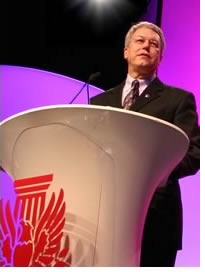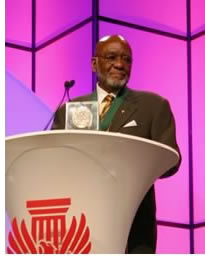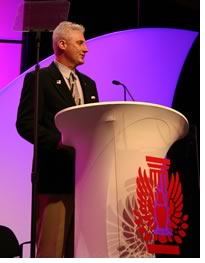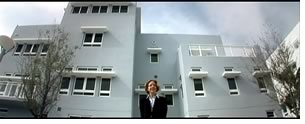

05/2005
Whitney Young winners honored; com*mun*it*y film debuts
 “Welcome
to the 137th National Convention of The American Institute of Architects—welcome
to the biggest gathering of architects on the planet!” said AIA
President Douglas L Steidl, FAIA, as he addressed the 137th national
convention gathered May 19 in Las Vegas. Steidl explained the convention
theme of The Power of Architecture: Imagine | Create | Transform. “We
live on a dynamic planet. It’s a jungle out there,” he said. “What
makes your community and my community possible is not the permission
of nature; it’s the power of architecture.”
“Welcome
to the 137th National Convention of The American Institute of Architects—welcome
to the biggest gathering of architects on the planet!” said AIA
President Douglas L Steidl, FAIA, as he addressed the 137th national
convention gathered May 19 in Las Vegas. Steidl explained the convention
theme of The Power of Architecture: Imagine | Create | Transform. “We
live on a dynamic planet. It’s a jungle out there,” he said. “What
makes your community and my community possible is not the permission
of nature; it’s the power of architecture.”
“But this power must be used wisely and with great skill if we are to imagine, create, and transform the raw materials of this planet into living, vibrant, healthy, sustainable, and livable communities,” Steidl continued. He used the lesson of Las Vegas as an example: “This town isn’t bigger than life: It is life! Life in all its pulsing, contradictory, impatient, and reckless energy,” Steidl said. “To those with a passion for the orderly and predictable, Las Vegas defiantly responds that “less is a bore.”
 “It takes a special person to represent this
town. Someone who understands the power of design to conjure an oasis
out of a wilderness,” the
AIA president explained. With that, he introduced Las Vegas Mayor Oscar
Goodman. Mayor Goodman proclaimed himself “the
happiest mayor in the universe,” due to the renaissance that his
city’s downtown has been undergoing since he first took office
in 1999. The city has been able to purchase 61 acres of brownfields,
which will be transformed into a new town center replete with university
medical center, city hall, and performance center, all ringed with high-rise
residential buildings. “Architectural excellence will go along
with the dream,” Mayor Goodman declared of the new planned “city
within a city.” He said Frank Gehry has agreed to design an Alzheimers
Center for the city, and he hopes other excellent architects will be
on board as well.
“It takes a special person to represent this
town. Someone who understands the power of design to conjure an oasis
out of a wilderness,” the
AIA president explained. With that, he introduced Las Vegas Mayor Oscar
Goodman. Mayor Goodman proclaimed himself “the
happiest mayor in the universe,” due to the renaissance that his
city’s downtown has been undergoing since he first took office
in 1999. The city has been able to purchase 61 acres of brownfields,
which will be transformed into a new town center replete with university
medical center, city hall, and performance center, all ringed with high-rise
residential buildings. “Architectural excellence will go along
with the dream,” Mayor Goodman declared of the new planned “city
within a city.” He said Frank Gehry has agreed to design an Alzheimers
Center for the city, and he hopes other excellent architects will be
on board as well.
Special delivery
In planning for the convention, Steidl explained, “We wanted to
raise the curtain with an event, a proclamation, a tour de force that
graphically makes the case, front and center, for the power of architecture.
We got our wish . . . and it has come special delivery via the United
States Postal Service!” The USPS complied with the unveiling of
the “Masterworks of Modern American Architecture” series
of stamps (see related story), followed by the presentation of Colors
by the Nellis Air Force Base Honor Guard and the singing of our national
anthem by a local U.S. Postal Service employee, Victor Fenimore.
 In the
spirit of social responsibility
In the
spirit of social responsibility
Steidl told the audience that during the 1968 convention, civil rights
activist Whitney Young Jr. challenged the profession on its lack of
diversity and compliance about civic responsibility. Young struck a
chord, and the profession in response created a special award in his
name to honor those individuals and organizations that exemplify the
profession’s responsibility to society. In honor of the 35th
anniversary of that award, the AIA presented Whitney Young Jr. Award
medals and trophies to all past recipients who were able to come to
the convention. Because 15 past AIA presidents were present, in most
cases, the new medal was given by the AIA president who made the original
award presentation.
Stanford R. Britt, FAIA, 2005 recipient of the Whitney M. Young Jr. Award, then joined the past award recipients to deliver his moving acceptance speech.
 “It is an unimaginable honor to stand on this stage with men I
have looked up to throughout my professional life,” Britt said,
naming in particular Max Bond, FAIA; Wendell Campbell, FAIA; Robert Coles,
FAIA; John S. Chase, FAIA; Leon Bridges, FAIA; Charles F. McAfee, FAIA;
and Robert Madison, FAIA, as men who were role models to him. “As
the Institute continues to be more inclusive, I look forward to a woman
standing among the Whitney M. Young Jr. Award winners very soon,” he
said. He also expressed gratitude to nominator Marshall Purnell, FAIA,
wife Edith, daughters Wande and Amara, all of his family, and “God’s
grace.”
“It is an unimaginable honor to stand on this stage with men I
have looked up to throughout my professional life,” Britt said,
naming in particular Max Bond, FAIA; Wendell Campbell, FAIA; Robert Coles,
FAIA; John S. Chase, FAIA; Leon Bridges, FAIA; Charles F. McAfee, FAIA;
and Robert Madison, FAIA, as men who were role models to him. “As
the Institute continues to be more inclusive, I look forward to a woman
standing among the Whitney M. Young Jr. Award winners very soon,” he
said. He also expressed gratitude to nominator Marshall Purnell, FAIA,
wife Edith, daughters Wande and Amara, all of his family, and “God’s
grace.”
Britt further singled out his mother, a teenage mom who highly valued education and took an active role in the PTAs of all the schools her boys attended. “Although things were difficult for her at times, she always found a way to give of herself to others. And it was assumed that her boys would do the same,” Britt said. He was particularly pleased that his Aunt Vivian, his mother’s younger sister, could be at convention to see him receive the award, “because this award honors my mother as much as it does me.”
Britt said that he thinks of himself as “the poster child for the AIA and its 40-year effort to be more inclusive.” In 1968, he received one of the first AIA/Ford Foundation Minority & Disadvantaged Scholarships, and he said, “As my mom would have it, I’ve worked hard to give back to others for the opportunities I’ve been given.” He believes that awarding scholarships is one of the most important things the Institute can do and challenged his fellow architects: “In the spirit of Mr. Young’s challenge let’s recommit ourselves to reaching back and helping others by doubling our scholarship program in 2007 our sesquicentennial year. Despite what many may say . . . very few of us make it on our own. Helping others should be the ultimate goal of the AIA.”
 ArchiPAC: The architect’s
voice on Capitol Hill
ArchiPAC: The architect’s
voice on Capitol Hill
President of AIA Florida and AIA ArchiPAC Chair Mickey Jacob, AIA, discussed
ArchiPAC, the AIA’s Federal Political Action Committee. He described
ArchiPAC as the “voice that shows elected officials that we are
willing to put more than just words behind our efforts as a vibrant,
politically active force.” Jacob explained that ArchiPAC raises
money from AIA members to contribute to candidates for the U.S. House
and U.S. Senate from both parties. Strong support for ArchiPAC, he
said, demonstrates to Congress that architects have an organized voice
and a message that matters. He told the audience that during the last
election cycle, more than 75 percent of ArchiPAC checks were hand delivered
by AIA members to the member of Congress in their home district.
 Building
a Blueprint for Community
Building
a Blueprint for Community
Steidl made reference several times to the AIA’s upcoming 150th
birthday. “It is not simply as an opportunity to celebrate the
contribution AIA members have made to their communities, but an advocacy
effort, a once-in-a-lifetime opportunity to raise the quality of life
in the places we live,” he said. “In short, let us approach
this milestone in our history as an opportunity for advocacy on behalf
of the public good. Let us work together with our neighbors to develop
a Blueprint for America.”
To further explore the architect’s role in building community, Steidl then introduced the Hon. Jeremy Harris, Hon. AIA, public director on the national AIA Board and former mayor of the City and County of Honolulu, known for his advocacy of community design. Harris called upon architects to “elevate, inspire, and educate people about community.” In his view, we live in the urban era, and our cities are in crisis through our development of “an unsustainable paradigm of consumerism and waste.” No one has stepped forward to define the new urban agenda, he said. “Who will lead us?” He told the architects, “The challenge to transform community is in your hands.”
 After Mayor Harris’ impassioned
speech, the audience was treated to the debut of com*mun*i*ty, a half-hour
film featuring observations, thoughts, and dreams of present and future
community. It featured 2005 Pritzker Prize winner Thom Mayne, FAIA; Las
Vegas megadeveloper Steve Wynn and his architect Tony Marnell, AIA; Elizabeth
Plater-Zyberk, FAIA; Julie Eizenberg, AIA; artist China Blue; and Navaho
cultural educator James Peshlakai, among others. The video, which will
be available to every AIA component, is intended to provoke discussion
about the future of community.
After Mayor Harris’ impassioned
speech, the audience was treated to the debut of com*mun*i*ty, a half-hour
film featuring observations, thoughts, and dreams of present and future
community. It featured 2005 Pritzker Prize winner Thom Mayne, FAIA; Las
Vegas megadeveloper Steve Wynn and his architect Tony Marnell, AIA; Elizabeth
Plater-Zyberk, FAIA; Julie Eizenberg, AIA; artist China Blue; and Navaho
cultural educator James Peshlakai, among others. The video, which will
be available to every AIA component, is intended to provoke discussion
about the future of community.
In conclusion, Steidl thanked all who participated in today’s program, saying, “They have opened imaginations and given us much to reflect on about the future of our communities when we return home. The future we study and plan for begins today. What role will you play?”
Copyright 2005 The American Institute of Architects.
All rights reserved. Home Page ![]()
![]()
 |
||
Click on a photo to view enlargement. Photos by Aaron Johnson, Innov8iv Design Inc.
|
||